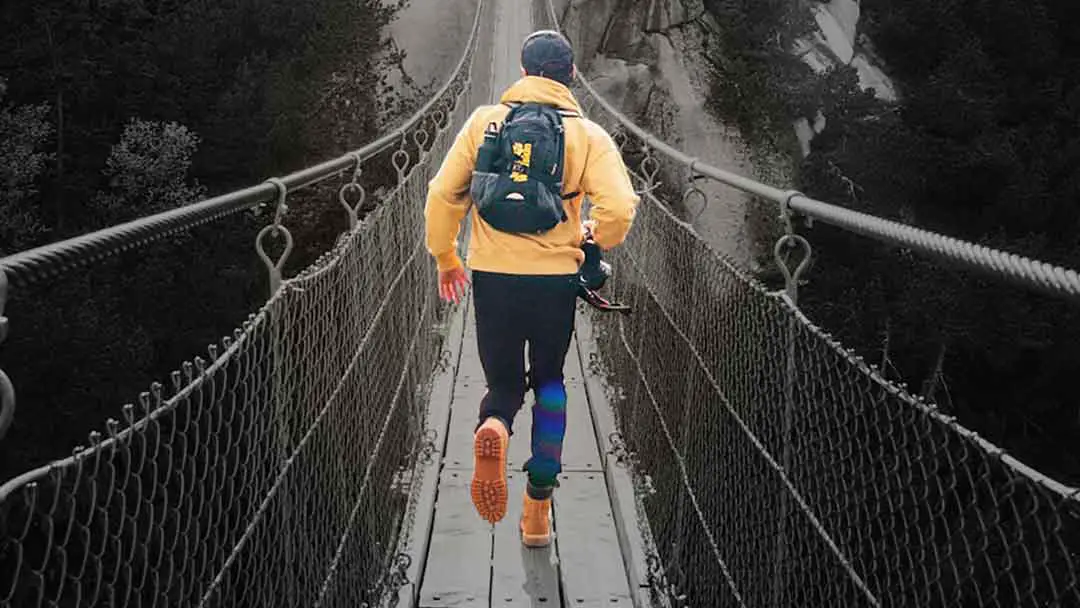What is Fastpacking? The Ultimate Guide

As an Amazon Associate we earn from qualifying purchases made on our website. If you make a purchase through links from this website, we may get a small share of the sale from Amazon and other similar affiliate programs. You can read our complete legal information for more details. By using this site, you agree the information contained here is for informational purposes only. For specific medical questions, consult your doctor. NO information on this site should be used to diagnose, treat, prevent or cure any disease or condition.
Insanely fun; fastpacking is a sport but a very niche one at that. It’s running or power hiking for several days while carrying only a modest quantity of gear, food, and drink.
You’ll be able to sleep under the stars wherever you land. It’s the kind of place where you cover a lot of ground and get even more breathtaking views.
While taking in views that would take a day or more to explore on foot, you may also practice your backcountry risk management and navigation abilities in this setting.
What exactly is “Fastpacking”?
Multi-day trail running and ultralight hiking collide in fastpacking. It’s possible to think of fastpacking in two different ways, depending on your previous experience and preferred style of hiking or running:
- By carrying less weight and covering more ground, ultralight camping allows you to experience more of nature than standard backpacking does.
- For those who plan to camp overnight, long-distance trail running allows one to immerse oneself in the wilderness fully. You can travel further and camp under the stars.
The most important thing to know about fastpacking is that it emphasizes the importance of carrying a compact and light backpack to move quickly over varied terrain.
Although few people like trail running with too much weight in their pack, those who plan to spend more than a day hiking and camping need to bring a lot more gear than those who plan to spend just one day on the trails.
Fastpacking is definitely not ultralight running as it’s not a race, and you usually need way more supplies.
Where to begin?
Like anything in life, we need a plan. These topics and ideas will help move you in the right fastpacking direction.
Start with a small goal in mind.
It’s not a good idea to embark on a multi-day, more than 100-mile hike without any preparation or experience.
To help your body get used to moving swiftly while carrying more weight and improve your fitness, consider trail jogging short distances on nearby trails with a laden backpack.
In fact, check out my personal fastpacking training routine here.
“Practice runs” like these can help you discover what aspects of your gear configuration work and don’t work for you. This will allow you to make improvements ahead of your big excursion.

Bring a friend or a group of people who will be there for you.
Having an experienced travel partner or crew is essential when deciding whether or not you’re ready for a more extended trip.
It would be more enjoyable and safer to go through this fantastic experience with a companion who has already seasoned in fastpacking.
What types of fastpacking would you prefer?
Fastpacking treks can be unsupported, self-supported, or supported.
A fastpacking trip that is entirely self-supported means packing only what you’ll need for the duration of the journey. Fastpacking at its most rudimentary.
Fastpackers are hikers that carry all of their supplies, such as food, clothing, and stove fuel, on their self-supported journeys. Post offices and shelters are common locations for resupplies.
Last but not least, supported fastpacking calls for the involvement of your friends. Checkpoints throughout the route are set aside for a crew to help a supported fast packer with supplies and any other assistance that may be needed.
If the supported fast packer is at an elite level, you will see them doing FKTs on specific routes (Fastest Known Times). This brings us to the sport aspect of fastpacking. Is it a sport? Nope, and we explain here.
Evaluate your fitness level
If you went to the gym, you wouldn’t try to squat the heaviest weight you could find. In the same way, try a one-night fastpack trip to see if you like it before committing to a longer journey.
If you succeed and enjoy it, continue onwards and upwards from there. When taking up a new sport for the first time, it’s a good idea to get into it slowly to prevent becoming overwhelmed.
I discuss my personal fastpacking training routine in “How to Train for Fastpacking Trips.”
Costs
Beginners to fastpacking often worry about how expensive the equipment is. The best piece of advice I can give you is to start with a small amount of gear and build it up as your budget allows.
Remember, if you buy cheap, you buy twice! Some equipment is expensive for a reason… It works!
Here is an awesome list of things fastpackers use in their kits, as well as the costs. Check out: How Much Does Fastpacking Cost? Gear Breakdown & List.
Tips to succeed
It’s straightforward to fail and lose interest in fastpacking. These tips will help set you up for success.
Have a Basic Understanding of Your Environment
Landmarks, terrain, gas stations, and hospitals are just some of the things to keep in mind when planning a trip.
Consider your research to be the most essential part of your planning. Your fastpacking trip will be more enjoyable if you have as much information as possible before your departure.
Be sensible with the mileage.
If your longest run is eight miles, perhaps you should fastpack about six to eight miles daily. Instead of overeating and being exhausted, it’s always better to have a little extra fuel in the tank at the end of the day.
Check the weather.
However, it’s essential to keep an eye on the weather during your trip, even if it’s just a few days before you go. Do not be afraid to cancel your trip if the weather is horrible; it’s not worth being “the hero.”
Is wildlife a concern?
Make sure you’re prepared for any wildlife sightings you may have along the way.
If you anticipate encounters with bears along your planned path, a bear sack may be necessary to preserve your camp supplies.
Using a bear bag, you may keep bears and other wild creatures at bay by suspending a kevlar bag from a tree branch and raising it above their heads.
Also, consider bear spray in case you run into a more aggressive one.
How technical is the terrain?
If you’re planning a journey that will take you to several different heights, you’ll want to be aware of the weather patterns at each one. Weather patterns can be drastically altered by as little as a few hundred feet in height.
Don’t get lost.
Bring a compass and a paper map with you. It is possible for a GPS to malfunction or for the battery to run out. Be sure to read this essential guide to planning a fastpacking trip!
Do you know the top 8 pros and cons of fastpacking? Here is the ultimate list.

What gear and kit do you need?
On every fastpacking trip, your kit may vary, but here are the essentials that most people carry:
Backpack
Bags with 20 to 40 liters of capacity are typical for Fastpacking. It is possible to go lighter and smaller for short trips in the summer. Winter necessitates the use of additional, generally bigger and heavier, equipment.
The heavier the pack, the more difficult it is for a runner to keep up with the pace and mileage they have planned.
Keep it easy and safe if your goal is to run as many miles as possible. To get a feel for how a pack moves, add weight to it during testing and try it out.
I personally use the Ultimate Direction The Fastpack 30
Sleeping bag
In addition, the design of your sleeping bag will be a really personal endeavor. Sleeping well is crucial because that is when your body regenerates the most.
I like a sleeping bag with a temperature rating of 10 or 15 degrees Fahrenheit lower than the predicted low temperature for wherever I’m going since I have difficulty falling asleep if I’m too cold.
I use a down sleeping bag for every single night’s sleep. Compared to their synthetic counterparts, they are lighter and take up less storage space.
Indeed a wet synthetic sleeping bag is better than a wet down sleeping bag, right? Whatever the material, a damp sleeping bag is a nightmare.
So, you are better off getting a down sleeping bag but taking the necessary steps to make sure you keep it dry. If you do that, there is no question down is best.
Investing in a high-quality, ultra-lightweight sleeping bag is not cheap. However, if you take good care of them, they can last for quite some time. Maybe upwards of 10 years, so the investment over ten years is relatively small.
I invested in the Rab Mythic Ultra 180, and I’m glad I did because it’s light and rugged and made with some intense technology.
Sleeping mat
The minimalist Fastpacker prefers to sleep on one’s side without a mat or a small, compact pad that provides just enough protection for one’s hip.
In my opinion, getting a good night’s sleep is essential; hence a light and quick-to-pack matt are essential.
Remember that a matt is required for insulation in the cold and snow, so check out the R rating.
It’s also important to keep in mind the likelihood of a hole. Many inflatable mats have become ultra-lightweight thanks to the use of ultra-lightweight materials.
Take caution and remove sharp objects before sitting or moving; always take a patch repair kit.
I mainly use the Therm-a-Rest NeoAir UberLite. It’s served me well over the years, and I know other fellow fastpackers that use it as well.
Place to sleep
A bivy is a fantastic choice if you need a small shelter that doesn’t take up as much space as a tent. They’re simple to use and a good option if you’re going to be fastpacking alone.
Nobody wants to wake up drenched after a night spent in a wet bivy bag, so research what tents and bivvy bags you can buy and if they suit the conditions you will be in.
If you are going to use a bivvy bag, I like to take an ultralight tarp as well for additional protection from the elements.
Clothing
Lightweight, water-resistant clothing is helpful because you want to be dry and comfortable simultaneously.
Keep your base layer free of sweat by looking for wick moisture garments. Polyester and spandex are your best bets.
Remember that your base layer is your last line of defense against the elements, whether rain, snow, or chilly weather. Having an extra pair of socks on hand is never a bad idea.
Cooking
The MSR PocketRocket Deluxe stove with a 100g gas canister has proven to be a good cooking setup for me.
Despite its small size and weight, it provides everything you need, allowing you to cook in numerous ways.
Additionally, Jetboil Stash Ultra Light, their new and lightest device, is great for boiling water, which might be all you need.
Food
A general rule of thumb from fastpacking experts: How many calories do you eat in a typical day, double it, and that’s how much food you need to take for one-day fastpacking. Then multiply that by how many days you are going for.
Your goal is to carry all those calories in the lightest grams possible. So, high calorie but light snacks.
For main meals, I like to take high-calorie dehydrated expedition-style foods. These can be over 1000kcal but only weigh around 200g because they have removed all the moisture. The added benefit is that they will not spoil in warm and humid conditions.
One of the highest quality, grass-fed, dehydrated meat companies out there is Carnivore Crisps. Plus, our readers get 10% off with this link or type in WILD at checkout.
For a full-on breakdown of fastpacking, nutrition, and how to pack food, check out this article, “Fastpacking & Nutrition | Must Have Food List.”
Water
Life can’t go on without water, and fastpackers need it even more than the average person. A multi-day, long-distance trip will require significant water, and bringing it all with you is impossible.
As a result, it’s vital that you stock up on water as you move throughout the day.
Make a note of where fresh water is on a map, and bring a water bottle with an attached water filter or filters that can be removed from the bottle’s cap with you.
In addition to being able to roll up and store in your pocket or pack, the Katadyn BeFree Water Filter Bottle is a collapsible soft bottle flask that can remove harmful organisms like bacteria and protozoa like Giardia & Cryptosporidium, exceeding EPA standards.
In other words, it’s suitable for filtering and cleaning water from water sources that are not safe for drinking.
Lighting
The reason you intend to use your fastpacking illumination is a crucial consideration. For night running or trekking, you’ll need a bright light to help you find your way and spot potential hazards.
Regarding ultralight night trail jogging, I’ve found the Zebralight headlamps to be the most light-efficient option. Combined with the included clip for fastening them to the brim of a cap, they weigh less than 90 grams.
The Petzl e+Lite is all you need if you just plan to use your light at camp. It weighs less than an ounce and may be used to set up a sleeping area, cook a meal, and read a map.
Always include an extra set of light batteries and a backup light in case you need them.
This was a quick dive into the basics of what’s needed on a fastpacking trip, and now you should really check out “The Ultimate Fastpacking Kit List.” This list goes through all the things I include on my trip and why I choose them.

Conclusion
Fastpacking is one of my favorite ways to see the world on foot, and I highly recommend it. Long-distance travel by oneself, usually point-to-point by one’s own power, is a tremendously satisfying experience.
Go at your own pace, take as long as you need, and fully engage in the surroundings and environment…you will love it.



